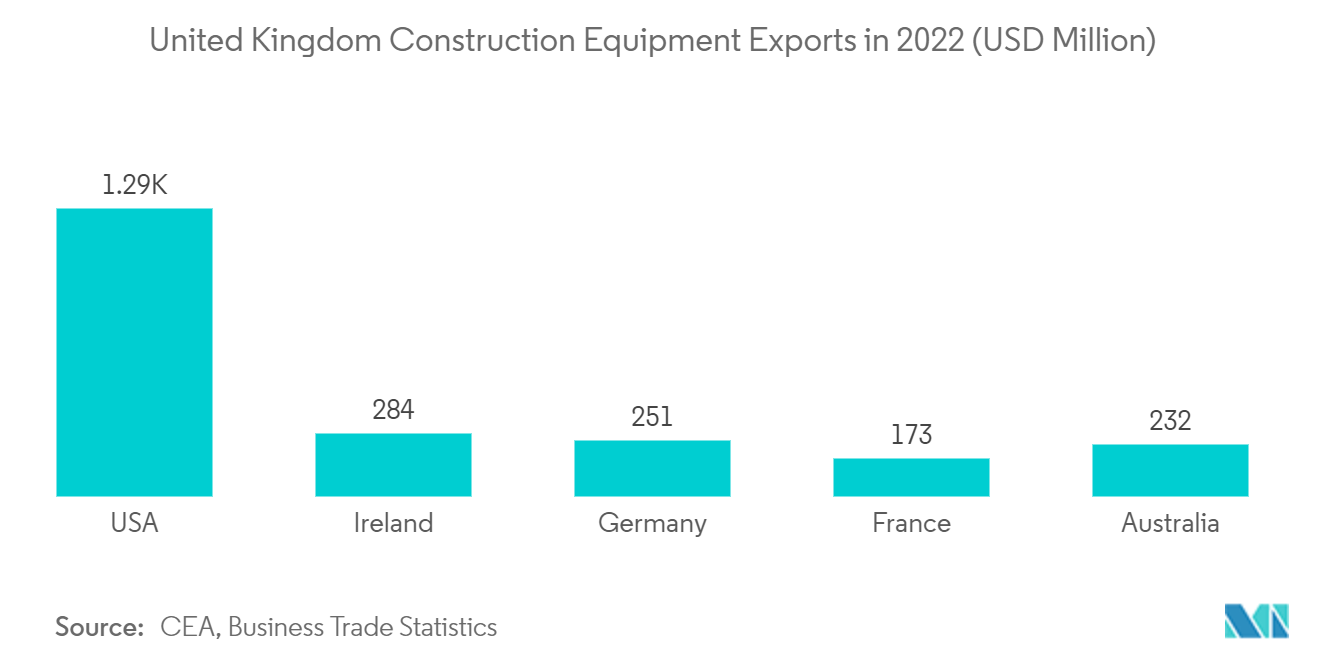Market Trends of Europe Excavator And Loaders Industry
Excavator Holds the Highest Share
Excavators are typically available in two types: wheeled excavators and crawler excavators. Most of the buyers purchased a low-cost crawler excavator over high-cost wheeled excavators because the former equipment offered high stability during digging operations on rough or uneven terrains compared to wheeled excavators.
With the evolving demand by the government to move toward greener vehicles, excavators and loader manufacturers are turning their conventional vehicles to electric and hybrid to adopt the changes. Most automakers are introducing new electric excavator models. For instance,
In November 2023, Holland displayed its first fully electric mini excavator. The E15X is one of the manufacturer’s new range of fifteen mini excavator models that have been designed with compact dimensions and has environmental credentials are further enhanced by its use of eco-friendly biological hydraulic oil, which also extends service intervals, and by the use of cobalt-free lithium batteries.
Up to 5-ton excavators are widely used for applications such as site preparation, building and landscaping, and moving to dig dirt, sand, gravel, and others. Several key players are introducing new models of excavators of up to 5 tons of capacity, which, in turn, is anticipated to boost the market during the forecast period. For instance,
In October 2022, Doosan Bobcat launched its new 2-ton battery electric excavator E10e at Bauma 2022 in Munich, Germany.
In July 2022, Hitachi Construction Machinery Europe N.V. launched Hitachi ZX55U-6EB, its first 5-ton battery-powered electric excavator in Europe.
Companies focus on the development of new models of excavators with enhanced performance characteristics and eco-friendly features to gain momentum in the market studied. This is expected to attract customers during the forecast period.

IC Engine is Expected to Hold the Highest Share
One of the major factors driving the growth of the market is the growing construction industry, especially in developing countries, owing to numerous growth opportunities in infrastructure, residential, and non-residential sectors. For instance
The rise in the construction of multi-family houses (with the growing trend of nuclear families), and increasing investments in the construction of roads, highways, smart cities, metros, bridges, and expressways due to the growing population and urbanization.
Moreover, The countries are investing heavily in infrastructure development to combat major issues such as traffic congestion, population growth, high manufacturing costs, and aging transportation infrastructure. Developed economies are investing in technologies such as earthquake-proof buildings, hyperloop, and so on to improve their current infrastructure. These factors are boosting the market’s growth.
According to Germany Rail Transport, rail freight transport will be increased by 25% by 2030, which, in turn, is likely to surge in demand for wheel loaders and excavators for the construction of railroads.
The situation in infrastructure construction looks more positive as many countries are investing in green energy and modernizing existing infrastructure. The situation in the construction markets of the individual European countries is very different. In April 2023, construction volume increased compared to the same month last year in Slovenia (by 23.3%), Romania (12.6%) and Belgium (8.7%). These factors will positively impact the target market growth during the forecast period.
Some of the companies are adopting different strategies to foster the demand for IC Engine excavators and loaders in the region. For instance,
In December 2022, CASE announced the launch of a four-model range of E-Series wheeled excavators, with plans to expand the range to include a fifth, larger model in the future. The machines will be built under an existing supply agreement with South Korean manufacturer Hyundai Construction Equipment.
The new CASE wheeled excavators are powered by Cummins EU Stage V diesel engines. The four smaller models will be equipped with a Cummins B4.5 engine that delivers an above-industry standard, outstanding maximum power of 129 kW. In contrast, the WX210E will likely be equipped with the larger B6.7 engine that delivers up to 145 kW and offers maximum performance. The engines have a highly efficient exhaust after-treatment module with a diesel oxidation catalyst (DOC), selective catalytic reduction (SCR), and diesel particulate filter (DPF).
Hence, the growing construction sector in some of the European countries and the development of new excavators and loaders equipped with diesel engines is expected to witness considerable growth in the target market in the upcoming years.


